There are 14 native species of turtles in South Carolina and 6 sea turtle species. In an effort to protect the turtles there was an executive bill from the state government was issued to stop poaching.
This is sadly necessary as a few of South Carolina’s native species are threatened or rare, such as the Bog turtle and Florida Softshell turtles. Many species are relatively common, like the Eastern Box and Common Musk turtle, meaning they can be observed in the wild.
South Carolina is also home to one species of tortoise, the endangered Gopher tortoise, as well as five species of sea turtles that can sometimes be seen off the coast. For these species, we have provided a few useful facts.
Here is our list of the native turtles in South Carolina.
Table of Contents
Turtles in South Carolina
1) Bog Turtle

- Experience Level: Beginner
- Family: Emydidae
- Scientific Name: Glyptemys Muhlenbergii
- Other Names: Muhlenberg’s turtle
- Adult Size: Between 3 ½ to 5 inches
- Lifespan: Up to 40 years
- Average Price Range: Between $250 and $450
The smallest species of turtle in North America, Bog turtles inhabit boggy and marshy areas. In South Carolina, Bog turtles are mainly confined to a few north western counties. Sadly, they are endangered due to habitat loss.
Also known as Muhlenberg’s turtle, Bog turtles have keeled shells that range from olive to dark brown, with yellowish markings on the side of their heads.
Bog turtles are omnivores and will mainly eat earthworms, mollusks, and invertebrates along with occasional pieces of vegetation. They are active during the warmest parts of the day and can eat on land or in the water.
2) Eastern Box Turtle
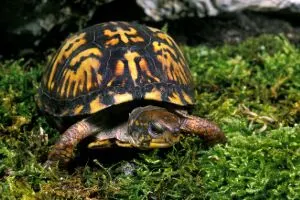
- Experience Level: Beginner
- Family: Emydidae
- Scientific Name: Terrapene Carolina Carolina
- Other Names: Common Box turtle, Land turtle
- Adult Size: Between 4 and 7 inches
- Lifespan: Up to 40 years
- Average Price Range: Between $120 and $400
- Recommended Books: Box Turtles: Complete Herp Care (Tess Cook)
A common species throughout South Carolina, Eastern Box turtles are a protected species that prefer woodland as well as wetland and grassland areas.
These turtles have high domed shells, often a dark brown, with distinctive orange markings. Their skin is also orange, with dark patches. Eastern Box turtles can also regenerate their shells.
These terrestrial turtles can roam up to 50 meters a day in search of food. Eastern Box turtles are omnivores, preferring plants and fungi but also consuming invertebrates, earthworms, or mollusks. Although mainly land-based, Eastern Box turtles will soak in puddles and shallow waters.
3) Chicken Turtle
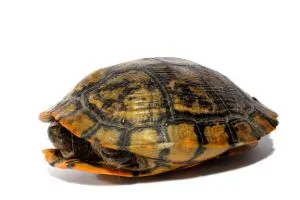
- Experience Level: Intermediate
- Family: Emydidae
- Scientific Name: Deirochelys Reticularia Reticularia
- Other Names: N/A
- Adult Size: Between 4 and 10 inches
- Lifespan: Between 15 and 30 years
- Average Price Range: Between $130 and $200
- Where To Buy: theturtlesource.com
Eastern Chicken turtles are a subspecies of Chicken turtle that are native to South Carolina. While they are relatively common in eastern and southern parts of the state, they may be in danger of habitat loss.
These turtles are a semi-aquatic species with long, striped necks and oval shaped shells. Coloring ranges from brown to olive ringed with yellow, with markings similar to the pattern of a net. They prefer wetland habitats with slow-moving waters.
Eastern Chicken turtles are omnivores who mainly feed on crayfish, small fish and amphibians, and invertebrates as well as plants. They hunt within dense vegetation.
4) Eastern River Cooter
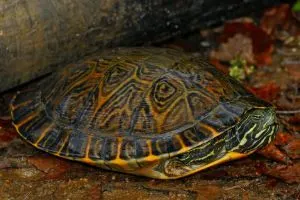
- Experience Level: Beginner to Intermediate
- Family: Emydidae
- Scientific Name: Pseudemys Concinna Concinna
- Other Names: N/A
- Adult Size: Between 8 and 12 inches
- Lifespan: Between 20 and 40 years
- Average Price Range: $20 to $50
- Recommended Books: Aquatic Turtles: Sliders, Cooters, Painted, and Map Turtles (R.D. Bartlett)
A freshwater semi-aquatic species, Eastern River Cooters are native to most areas of South Carolina. They are usually found in rivers and streams and can sometimes be seen basking on rocks or logs at the edge of the water.
These turtles have slightly domed shells ranging from brown to olive. Their shells have beautiful yellowish swirling markings, with yellow edges and fluted rear scutes. They are distinguished from Florida Cooters via small crescent-shaped markings on each side of their shell.
Eastern River Cooters are mainly herbivores, preferring to eat plants and other vegetation instead of crayfish or amphibians.
5) Florida Cooter

- Experience Level: Beginner to Intermediate
- Family: Emydidae
- Scientific Name: Pseudemys Floridana
- Other Names: Coastal Plain Cooter
- Adult Size: Between 8 and 12 inches
- Lifespan: Between 20 and 40 years
- Average Price Range: $20 to $50
- Where To Buy: theturtlesource.com
- Recommended Books: Aquatic Turtles: Sliders, Cooters, Painted, and Map Turtles (R.D. Bartlett)
Florida Cooters are a semi-aquatic, freshwater turtle found in south eastern areas of South Carolina. They are usually found on coastal plains and prefer water bodies that have sandy depths such as rivers or swamps.
Florida Cooters have a relatively flat shape compared to other species. They have dark green shells with swirling orange patterning. Their plastrons are plain yellow, with a series of oval-shaped black markings.
These Cooters can often be seen basking together on logs, sometimes in social groups. While all omnivores, females prefer to eat plants while males hunt invertebrates or crayfish.
6) Diamond-backed Terrapin

- Experience Level: Beginner to Intermediate
- Family: Emydidae
- Scientific Name: Malaclemys Terrapin
- Other Names: N/A
- Adult Size: 4 ½ to 5 ½ inches (Males) and 6 to 9 inches (Females)
- Lifespan: Between 25 and 40 years
- Average Price Range: Between $250 to $300
- Recommended Books: Map Turtles and Diamondback Terrapins by W.P. (Mara)
Diamond-backed Terrapins can be found along much of the Eastern Coast, including South Carolina. They favor brackish waters such as marshes and tidal estuaries, and can often be seen swimming along with their heads poking out like periscopes.
Diamond-backed terrapins have distinctive gray skin with black speckling. Their shells can range from dark green to black, with a series of keels running down the spine of their carapace. Their scutes are diamond-shaped, with concentric rings ranging from yellow to black.
These terrapins consume crustaceans and mollusks as well as shellfish like clams or winkles. They will also occasionally eat vegetation.
7) Eastern Mud Turtle
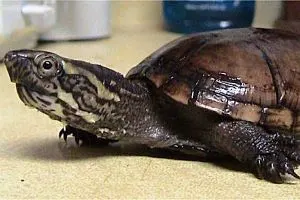
- Experience Level: Beginner
- Family: Kinosternidae
- Scientific Name: Kinosternon Subrubrum
- Other Names: Common Mud turtle
- Adult Size: Between 3 and 5 inches
- Lifespan: Up to 50 years
- Average Price Range: $40 to $100
Eastern Mud turtles are common throughout much of South Carolina. They prefer shallow, slow-moving waters such as bogs, swamps, and tidal marshes. They are fairly active on land and will explore away from water, burrowing themselves in mud to hibernate.
These turtles have shells ranging from brown to green or yellowish. Their carapaces are smooth and oval-shaped, but drop quite sharply at the back and sides. Mud turtles have larger plastrons than Musk turtles.
Eastern Mud turtles are omnivores and will usually eat worms, snails and other mollusks and sometimes fish. They will also occasionally consume vegetation.
8) Striped Mud Turtle

- Experience Level: Beginner
- Family: Kinosternidae
- Scientific Name: Kinosternon Baurii
- Other Names: Three striped mud turtle
- Adult Size: Between 4 and 5 inches
- Lifespan: Up to 50 years
- Average Price Range: Between $75 and $160
Striped Mud turtles can be easily identified by the three light stripes running down their dark brown shells. These are often seen only when wet. More stripes, often yellowish in color, stretch between their eyes and nostrils.
Striped Mud turtles are found in south eastern parts of South Carolina. They mainly inhabit still freshwater creeks and rivers near floodplains. They can also be found in swamps.
These turtles are omnivorous, mainly consuming mollusks, worms, invertebrates, and fish as well as occasionally eating plants and algae. They also tend to move around a lot on land.
9) Common Musk Turtle
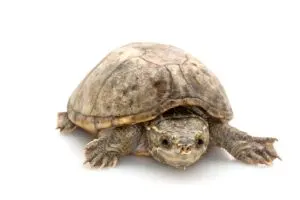
- Experience Level: Intermediate
- Family: Kinosternidae
- Scientific Name: Sternotherus Odoratus
- Other Names: Stinkpot, Eastern Musk turtle
- Adult Size: Between 4 and 5 inches
- Lifespan: 50 years and over
- Average Price Range: Between $20 and $90
- Where To Buy: theturtlesource.com, undergroundreptiles.com
Also known as “Stinkpots” thanks to the strong odor they can excrete from their musk glands, Common Musk turtles are common throughout South Carolina. They use this unique feature as a defense mechanism against predators.
Common Musk turtles have dark brown or black unmarked shells. Their heads are also dark, with two yellowish stripes as well as fleshy barbels on their chins and necks.
Common Musk turtles are nocturnal omnivores and mainly eat mollusks, crustaceans and small amphibians. They prefer marshy and boggy habitats with slow-moving waters. Unusually, they are also prolific climbers and sometimes climb trees.
10) Eastern Painted Turtle
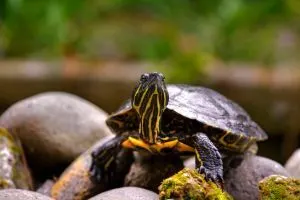
- Experience Level: Beginner
- Family: Emydidae
- Scientific Name: Chrysemys Picta
- Other Names: N/A
- Adult Size: Between 4 and 10 inches
- Lifespan: Between 30 and 50 years
- Average Price Range: Between $20 and $50
- Recommended Books: Painted Turtle Pet Owners Guide (Ben Team)
Eastern Painted turtles are the native Painted turtle subspecies in South Carolina. A popular pet turtle species, they are found in north western areas of South Carolina.
Painted turtles have dark shells, often edged in colors ranging from yellow to red. Their dark skin also has faint yellow stripe markings, especially on their faces. Eastern Painted turtles have yellow plastrons.
Painted turtles are an aquatic species, often basking near the water. As omnivores, Painted turtles mainly eat amphibians, mollusks, and aquatic invertebrates. Due to their fixed tongues they must swallow food whilst in the water.
11) Yellow-bellied Slider

- Experience Level: Beginner
- Family: Emydidae
- Scientific Name: Trachemys Scripta Scripta
- Other Names: N/A
- Adult Size: Between 5 and 12 inches
- Lifespan: Between 20 and 40 years
- Average Price Range: Between $15 and $50
- Recommended Books: Aquatic Turtles – Complete Herp Care (David T. Kirkpatrick)
Yellow-bellied Sliders inhabit most areas of South Carolina, except for extreme north western counties. They are mainly found in wetland habitats such as rivers and lakes. They can sometimes be seen on land as they move between suitable habitats.
As their name implies, these turtles have yellowish plastrons, as well as yellow markings across their skin. Yellow-bellied Sliders also have prominent yellow stripes behind their eyes. Their shells range from dark brown to olive.
Yellow-bellied Sliders are diurnal omnivores, mainly consuming aquatic vegetation as well as invertebrates, mollusks, and small fish and tadpoles. They often bask on the shore.
12) Common Snapping Turtle
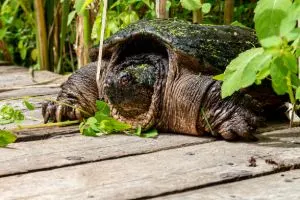
- Experience Level: Intermediate to Expert
- Family: Chelydridae
- Scientific Name: Chelydra Serpentina
- Other Names: Common Snapper, Eastern Snapping turtle, Snapper
- Adult Size: Between 8 and 20 inches
- Lifespan: Between 30 and 50 years
- Average Price Range: Between $20 and $40
- Recommended Books: Snapping Turtle Pet Owners Guide (Ben Team)
Common Snapping turtles are a large freshwater species that is widespread across most areas of South Carolina. They can be aggressive and will often hiss and bite. They mainly inhabit larger bodies of water, sometimes even brackish areas.
Common Snapping turtles usually have rough shells ranging from dark brown to green. They are have distinctive hooked beaks as well as strong claws and long tails covered with saw-toothed spines.
They are nocturnal omnivores, mainly eating fish and other aquatic prey, and will even catch and eat small waterbirds if they get close enough. They also consume underwater vegetation.
13) Florida Softshell Turtle

- Experience Level: Intermediate to Expert
- Family: Trionychidae
- Scientific Name: Apalone Ferox
- Other Names: N/A
- Adult Size: Between 6 and 12 inches (Males), between 11 to 24 inches (Females)
- Lifespan: Between 25 and 35 years
- Average Price Range: Between $40 and $180
- Recommended Books: Softshell Turtle Pet Care Guide by Ben Team
Florida Softshells are a large, mainly aquatic species. They resemble leathery pancakes, and lack a hard carapace. Their shells are usually brown or olive, and their undersides range from cream to gray. Florida Softshells are the largest Softshell species in the United States.
Florida Softshells are found only in southern areas of South Carolina. They spend most of their time underwater and prefer slower-moving currents and mainly inhabit lakes and streams.
These Softshells are mainly carnivores, eating amphibians, mollusks, crustaceans, fish, and even other turtles. They have even been known to consume small wildfowl and water birds.
14) Spiny Softshell Turtle
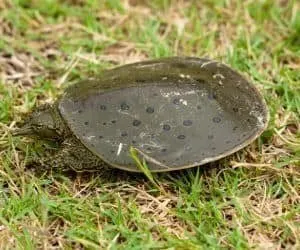
- Experience Level: Intermediate to Expert
- Family: Trionychidae
- Scientific Name: Apalone Spinifera
- Other Names: N/A
- Adult Size: 5 to 9 ½ inches for males, 7 to 17 inches for females
- Lifespan: Between 20 and 50 years
- Average Price Range: Between $70 and $280
- Recommended Books: Softshell Turtle Pet Care Guide by Ben Team
Spiny Softshell turtles are common across much of South Carolina, mainly in rivers or streams with a moving current. They are fast swimmers and will scratch and bite if caught or handled. Their shells feel a bit like sandpaper.
Spiny Softshells have a leathery shell shaped like a pancake, sporting several dark spot markings. They have long, tapered beaks which they use to breathe while buried in the sand and awaiting prey.
These Softshells are carnivores and will feed on any crustaceans, insects, and mollusks that swim past their hiding place. They then grab their prey in their mouths.
There is also one species of tortoise that is native to South Carolina; the Gopher tortoise. This endangered species has suffered from the loss of its preferred grassland habitats, where it digs burrows and is a keystone species.
In South Carolina, the Gopher tortoise is only found in extreme southern areas. Here are a few facts about the Gopher tortoise.
15) Gopher Tortoise

- Family: Testudinidae
- Scientific Name: Gopherus Polyphemus
- Adult Size: Between 10 and 15 inches
- Weight: Between 10 and 20 pounds
- Lifespan: Between 40 and 60 years in the wild
- Conservation Status: Endangered
- Habitat: Grasslands, where they dig burrows
- Clutch Size: Up to 25 eggs
- Food: Herbivores – plants and fruits and berries
- Appearance: Large tortoises with dark brown to gray shells. Elephant-like hind-legs.
Check out our Gopher Tortoise page for more information.
Five species of sea turtles can be seen off the coast of South Carolina. Sadly, all of these species are endangered. These turtles mainly appear around areas such as South Carolina to breed.
The five species are the Green sea turtle, Hawksbill sea turtle, Kemp’s Ridley sea turtle, and the Leatherback and Loggerhead sea turtles. The Loggerhead sea turtle is the state reptile of South Carolina.
Even though they cannot be kept as pets, we’ve provided a few facts about each species in case you spot one in the wild.
Sea Turtles in South Carolina
16) Green Sea Turtle
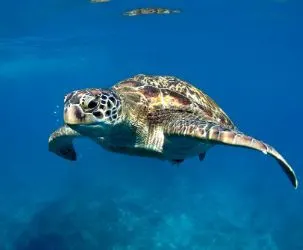
- Family: Cheloniidae
- Scientific Name: Chelonia Mydas
- Adult Size: Between 3 and 4 feet
- Weight: Between 300 and 400 lbs
- Lifespan: Between 80 and 100 years
- Conservation Status: Endangered
- Habitat: Bays and shores along coastlines and open ocean waters, seen during summer months
- Clutch Size: Around 110 to 115 eggs, with 2 to 5 clutches per breeding season
- Food: Mostly herbivores, eating algae, sea grasses and seaweed
- Appearance: Smooth green to brown shells shaped like hearts, edged in yellow. Cream colored scaly skin with shades of green
Visit our Green Sea turtles page for more information.
17) Hawksbill Sea Turtle

- Family: Cheloniidae
- Scientific Name: Eretmochelys Imbricata
- Adult Size: Between 30 and 35 inches
- Weight: Between 100 to 155 lbs
- Lifespan: Between 30 and 50 years
- Conservation Status: Critically Endangered
- Habitat: Shallow coastal areas of rocky or tropical waters, reefs and estuaries
- Clutch Size: Between 140 to 200 eggs, about 4 clutches per breeding season
- Food: Omnivores, mainly consuming crustaceans, mollusks, and algae
- Appearance: Prominent, beak-shaped mouths (like a hawk), oval shells in shades of amber with unique markings. Flippers also have claws at their “elbows”
For more information, head to our Hawksbill Sea turtle page.
18) Kemp’s Ridley Sea Turtle
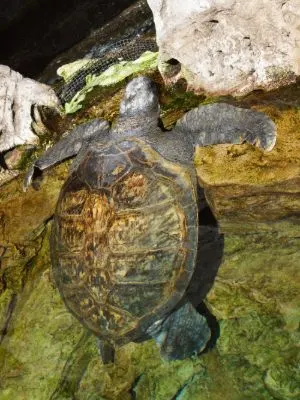
- Family: Cheloniidae
- Scientific Name: Lepidochelys Kempii
- Adult Size: Around 25 inches
- Weight: Between 75 and 100 lbs
- Lifespan: Around 30 years
- Conservation Status: Critically Endangered
- Habitat: Sandy or muddy coastlines with shallow waters
- Clutch Size: Between 100 and 110 eggs, 2 to 3 clutches per breeding season
- Food: Crustaceans, shellfish
- Appearance: Slightly hooked beaks, triangle-shaped heads. Green to gray round shells. Muted cream or yellow plastrons and undersides.
Check out our Ridley sea turtle page for more information.
19) Leatherback Turtle

- Family: Dermochelyidea
- Scientific Name: Dermochelys Coriacea
- Adult Size: Between 6 and 7 feet
- Weight: Between 1200 and 1450 lbs
- Lifespan: Around 30 years
- Conservation Status: Vulnerable
- Habitat: Warm waters, mainly shallow, calm bays or lagoons. Nests common on sandy beaches.
- Clutch Size: Between 100 and 110 eggs
- Food: Jellyfish is the staple of their diet, but they will also eat other sea creatures
- Appearance: Their large carapaces are soft, unique among sea turtles, with prominent ridges all the way down. Colors vary between black and a dark gray.
For more information, please see our Leatherback sea turtle page.
20) Loggerhead Sea Turtle

- Family: Cheloniidae
- Scientific Name: Caretta Caretta
- Adult Size: Between 30 and 45 inches
- Weight: Approximately 155 pounds
- Lifespan: Between 70 and 80 years
- Conservation Status: Endangered
- Habitat: Coastal regions, mainly shallow bays. Prefer sub-tropical waters. Sandy ocean beaches for nesting
- Clutch Size: Between 100 and 125 eggs, 4 to 5 clutches per breeding season
- Food: Carnivorous, mainly eating shellfish, mollusks, and crustaceans
- Appearance: Largest hard-shelled turtles with a reddish-brown carapace and large heads. Undersides are cream to yellowish. Long powerful flippers
Head to our Loggerhead sea turtle page for more information.
Wrapping Up
Those are the 20 species of turtles that can be found in South Carolina. There was a wide variety including sea turtles, a tortois, and plenty of aquatic species.
What did you think? Have you seen any turtles in South Carolina that we didn’t have on our list?
Other nearby states
